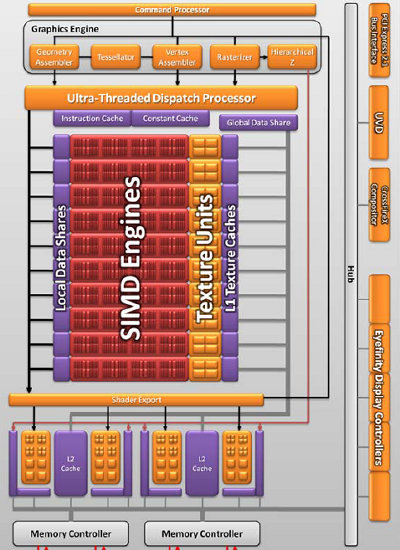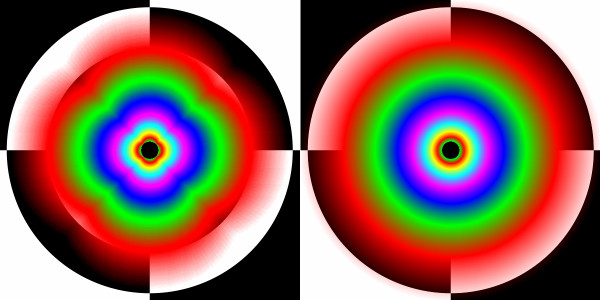RV840 Juniper architecture
We have already reviewed the overhauled RV8xx architecture codenamed TeraScale 2 above. Juniper differs from Cypress mostly on the quantitative level. All parameters of the new GPU are halved: computing capacity, texel rate, ROPs. It corresponds to the top RV770 in these characteristics. Probably that was the intention of its engineers.
Although the RV8xx has no cardinal changes, it develops ideas of previous generations, almost all its units feature minor modifications: stream processors, texture units, ROPs, output controllers. Juniper's flow chart resembles that of Cypress:
The main part of the RV840 chip consists of ten SIMD cores (just as many as in the RV770), each one containing 16 blocks of superscalar streaming processors. The superscalar nature of these processors hasn't changed since RV670. According to AMD, the GPU contains 10*16*5=800 scalar 32-bit streaming processors.
All features of the GPU remain the same. Except for one important feature that has to do with GPU computations. As you may remember, the same units are used for 64-bit computations of double precision in previous GPUs, but the computing rate drops. However, according to official specifications published on the AMD's website, the RV840 Juniper does not support double precision calculations.
Is it bad or is it possible to do without double precision in relatively inexpensive GPUs? That's not very good for GPU computing, of course. It's always useful to have identical features for all GPUs for any price range. On the other hand, if it helps cut down manufacturing costs and prices for end users, it really makes sense. Even single precision is rarely used in domestic GPGPU tasks, to say nothing of double precision.
So, relatively many stream processors in combination with the other modifications (the increased number of instructions executed per cycle, MUL and ADD execution per cycle, a new instruction Sum of Absolute Differences) give the RV840 high performance in single precision computing (both generic and graphical).
All new GPUs of the RV8xx series, including the RV840 Juniper, support the new algorithm of anisotropic filtering that offers higher quality. Texture MIP levels are not arranged in perfect circles. Here is a comparison of the old and the new algorithms (pay attention to smoothness of transitions between MIP levels and geometric accuracy of circles):
You can read about the other changes in TMUs and ROPs above. The new solutions now support supersampling to antialias not only polygon edges, but also textures, and pixel shaders, which improves the overall render quality.
The new mid-end GPU possesses the same memory controllers of GDDR5 memory, which were optimized in the RV8xx architecture. On the whole, everything is just like in Cypress, except for the relatively low video memory bandwidth, which may be the bottleneck of the HD 5700 series. However, the 128-bit bus also makes sense, as the GPU surface has been reduced, and it's of paramount importance for AMD to provide low manufacturing costs. And GDDR5 memory bandwidth with a 128-bit bus is actually sufficient for such graphics cards. However, in some cases we can expect this card to be outperformed by the HD 4870/4890 with significantly higher memory bandwidth provided by the 256-bit memory bus.
PCI Express 2.1
Although motherboards are now limited to PCI Express 2.0, and PCISIG delayed Specs 3.0, the new family of graphics cards from AMD support PCI-E 2.1. At least in their specifications.
There are not that many differences, as we could have assumed from the increase in the standard version. The main objective of the future Version 3.0 is higher performance, but Version 2.1 can also accelerate data exchange rates in some cases. And some of the changes planned in Specs 3.0 were implemented in Version 2.1. They are added for better support of devices that require fast data transfer rates, such as GPUs.
Let's describe the main changes in PCI Express 2.1 versus PCI Express 2.0.
- Internal Error Reporting -- Information about internal errors has now become available to program code.
- Atomic Operations -- Support for atomic operations that helps distribute tasks between CPU cores and graphics cards.
- Resizable BAR Capability -- Determining the amount of system resources allocated to devices.
- Dynamic Power Allocation -- Software control of power states.
- ID-based Ordering -- Reducing delays caused by non-optimal order of commands.
- Latency Tolerance Reporting -- Improvements in resources distribution.
- Alternative Routing-ID Interpretation -- Support for more internal functions of devices.
These are only some of changes in the new version of PCI Express. Unfortunately, we cannot test how much faster the new version is compared to the second version of PCI-E, we just have no appropriate motherboards. We'll run the test, as soon as we have an opportunity.
Data output, power management, etc.
The new solutions announced by AMD for the mid-end market also support an interesting technology of simultaneous video output to three devices - Eyefinity. Advanced support for multimonitor configurations (to plug three or six monitors to a single graphics card) may be useful in games and in professional applications.
Video output in the RV8xx was overhauled to support up to six displays (using special modifications of the graphics card) in various combinations. The number of supported monitors depends on a given configuration of the card, it can reach six or three. The GPU has six integrated TMDS transmitters. In usual graphics cards four of them support two Dual Link DVIs, so it's possible to plug up to three monitors to them.
Support for three monitors, unlike two in the previous solutions, is not a very important advantage. Hardly many users of this mid-end card will install three monitors. It's easier to buy one large monitor or a TV set. So this is a useful feature, but it's not an advantage.
On the other hand, the new audio output via HDMI is definitely an advantage. Like the top family, ATI RADEON HD 5700 cards support HDMI 1.3a and high-quality audio transfer (Dolby TrueHD and DTS-HD Master Audio) from Blu-ray via HDMI. While it's not relevant in case of expensive HD 5800 cards, the relatively inexpensive HD 5750 can be used to build HTPC, and that feature will be very useful there.
The new cards support a dynamic power management technology called ATI PowerPlay. Power consumption of the new cards in the idle mode is reduced by lower GPU/memory frequencies and voltages as well as a special GDDR5 memory mode. As a result, HD 5700 cards consume only 16-18 W in the idle mode, it's really very little. Under full GPU load, frequencies and voltage will be set to maximum, and power consumption will exceed 80-100 W, not bad for such performance.
Write a comment below. No registration needed!



